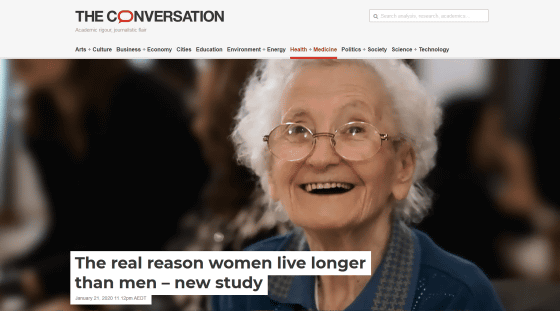Research results that variation in life expectancy difference between men and women can be explained by 'smoking fashion pattern'

by
Smoking habits are known to have a variety of negative effects on health, and in recent years there has been an increasing trend to quit smoking worldwide. Meanwhile, an analysis conducted by research teams at the University of Southern Denmark and the University of Groningen showed that the change in gender differences in average life expectancy that occurred from 1950 to 2015 can be explained by the prevalence pattern of smoking. it was done.
Progression of the smoking epidemic in high-income regions and its effects on male-female survival differences: a cohort-by-age analysis of 17 countries | BMC Public Health | Full Text
https://bmcpublichealth.biomedcentral.com/articles/10.1186/s12889-020-8148-4
The real reason women live longer than men – new study
https://theconversation.com/the-real-reason-women-live-longer-than-men-new-study-130142

The research team looked at life expectancy among people aged 50 to 85 living in high-income countries in North America, Europe, and Oceania from 1950 to 2015. According to the survey, women's life expectancy was about two and a half years longer in men than men in 1950, but around 1980 the difference in life expectancy between men and women increased to four and a half years. After that, the average life expectancy difference between men and women narrowed again, and in 2015 the difference in average life expectancy was only two years.
The research team analyzed the change in life expectancy difference between men and women, and found that all changes in life expectancy difference between men and women between 1950 and 2015 can be explained by changes in smoking habits.

by
In the surveyed Anglo-Saxon high-income countries, it was confirmed that there was a common 'smoking epidemic pattern'. For example, more than 50% of American men in the 1950s were smokers, while women smoked only around 24%. In 2015, the male smoker rate fell below 20%, while the female smoker rate remained at around 12-15%, and the male and female smoker rates are approaching with the times. The researchers argue that this gender difference in smoking prevalence patterns manifested as differences in life expectancy.
The figure below shows the “smoking prevalence pattern” in the surveyed countries. First, men's smoking rate increased around 1900, and after about 10 years, women's smoking rate increased. Later on, a pattern can be seen in which the number of deaths associated with smoking in men increased, followed by an increase in the number of deaths associated with smoking in women. In the end, smoking rates declined in men and women, but around 2000, the number of deaths related to men decreased gradually, while that related to women The death toll continues to increase. The research team noted that this smoking prevalence pattern is linked to the average life expectancy difference between men and women.

In fact, when the research team calculated the average life expectancy only for non-smokers between the ages of 50 and 85, the average life expectancy difference between men and women was consistently about 2 years during the period 1950-2015. did. This is almost the same as the average life expectancy difference between men and women as of 2015, and indicates that the difference in smoking habits does not significantly affect the difference in average life expectancy in 2015.
The research team says that smoking takes decades to kill a person about why people do not quit smoking despite smoking habits clearly affecting mortality . If smoking causes fatal illness immediately, many people hesitate to smoke, but many people smoke because smoking does not immediately lead to death.
The research team described the 'good news from the study' as saying, 'In recent years, the number of deaths associated with smoking in people aged 50 and over has dropped significantly.' Although not all smokers are gone, at least the perception that smoking is not good for health is quite widespread.

by kenishirotie
Related Posts:
in Note, Posted by log1h_ik







